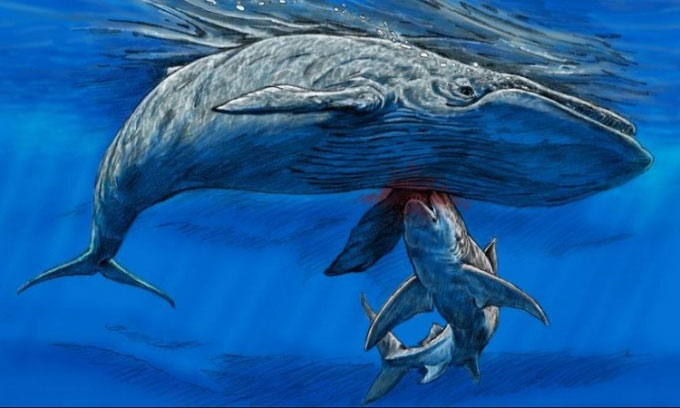New fossil revealed, giant shark eats ancient whales
The flipper fossil reveals a large shark that ate the carcasses of baleen whales floating in the sea 15 million years ago.
A voracious shark, possibly megalodon ( Otodus megalodon ), the largest shark to have ever lived on Earth, ate baleen whales 15 million years ago in what is now Maryland, according to new research about the flippers of whales. However, analysis of the bite marks on the flippers revealed that the whale was probably already dead and floating on the water. Therefore, the giant shark is more likely to eat the decomposing carcass, grab the flippers and snatch pieces of meat from the whale's head.

Reconstruction of shark eating ancient whale carcass on the water. (Photo: Tim Scheirer and Clarence (Shoe) Schumaker)
"Bite and tear marks including shallow arc-shaped perforations on flippers are evidence of scavenging behavior rather than active predation," said study leader Stephen Godfrey, manager of paleontology at the University of California. Calvert Marine Museum in Solomons, Maryland.
Fossil collector William (Douggie) Douglass of Maryland discovered whale bones dating from the Middle Ages (5.3 - 23 million years ago) on a beach near Calvert natural erosion cliffs, floating area. famous for marine fossils. During the Middle Ages, the Atlantic Ocean covered the Chesapeake region of present-day Maryland. The fossil-filled sediments that form today's cliffs were submerged 9-20 million years ago.
Douglass donated whale bone fossils to the Calvert Marine Museum. The 27.5 cm long clavicle is quite flattened and has a slightly curved shape, a characteristic that indicates it belongs to a baleen whale. Godfrey and intern Annie Lowry found bite marks on both sides of the collarbone.
"The shark must have grabbed the flippers very tightly, then jerked its head very hard to break the bone or to tear the flesh. After it got some meat, it bit the flippers again to get more meat , " Godfrey said. speculate. "When the whale dies, its body turns upside down and floats on the surface of the water due to the gas that accumulates in its belly from the decomposition process. The scavenger shark frequently feeds on the surface of the water, sometimes sticking its head up, so that The whale's flippers become an easy target for the great shark."
The whale shark may be among the following species: Alopias grandis, Alopias palatasi, Carcharhinus, Carcharodon hastalis, Galeocerdo aduncus, Hemipristis serra , juvenile O. megalodon shark , Physogaleus contortus and Sphyrna laevissima . The bite does not reveal whether the shark has serrated teeth or not. If the markings were not caused by jagged teeth, the culprit is more likely to be Carcharodon hastalis , the ancestor of today's great white sharks.
The team published their findings on October 24 in the journal Carnets Geology and will present them online November 5 at the annual meeting of the Society of Vertebrate Paleontology.
- Discovered shark head 330 million years in caves in the United States
- Detection of giant shark fossils 300 million years
- Unexpectedly discovered fossil teeth Megalodon 8cm long when walking the dog
- The 'whale' is about the size of a dinosaur
- A giant shark species was discovered
- Discover the tooth 5 million years of giant killer whale
- Found huge shark teeth
- Discovered the world's largest ancient shark tooth about the size of a hand
- Mysterious skull of ancient whale
- 10 giant animals on the ocean floor
- Ancient sharks migrate to lay eggs
- Detecting ancient whale fossils with strange shapes
 Discovered an ancient centipede fossil 99 million years old
Discovered an ancient centipede fossil 99 million years old Discovered bat-like dinosaurs in China
Discovered bat-like dinosaurs in China Discovered a 200-year-old bronze cannon of the coast
Discovered a 200-year-old bronze cannon of the coast Discover 305 million-year-old spider fossils
Discover 305 million-year-old spider fossils